With the MINI Clubman only available to order, the Countryman now becomes the only option in the MINI range if you want a 5-door version off the showroom floor, and it’s the largest MINI in the range too.
Released in 2020, the Countryman now has plug-in hybrid (PHEV) capability, giving an electric-only range of around 50km. With a price difference of around $10,000 but with added all-wheel drive, is the 2023 MINI Countryman Hybrid worth buying? We drove one for a week and 700km to find out.
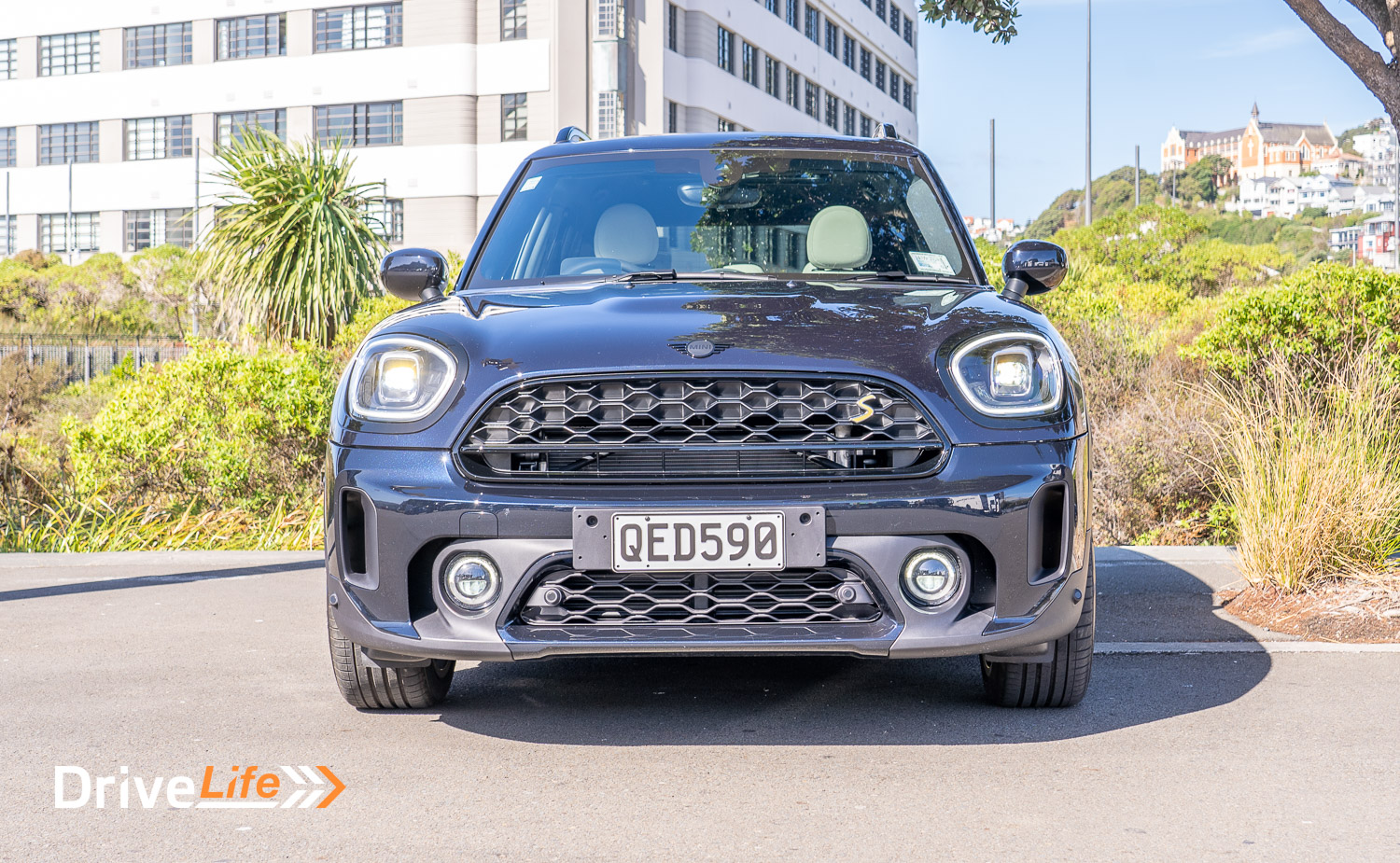
What We Like and Dislike About The MINI Countryman Hybrid Yours
| What we like | What we don’t like |
| Interior is stunning Design Sense of space inside Fun to drive Performance Brakes Engine noise All-wheel drive grip Visibility is outstanding EV/petrol transition very smooth | No adaptive cruise Road, tyre, and wind noise levels No power seats Audio quality No blind spot monitoring |
What’s In The 2023 MINI Countryman Range?
It seems MINI is trying to get everyone into a Countryman, with six models available. The Countryman Cooper has MINI’s Twinpower engine, so that means a 1,500cc, turbocharged 3-cylinder petrol motor. It has an output of 100kW, torque is listed at 220Nm and is mated to a 7-speed Steptronic transmission with a double clutch. Fuel consumption is rated at 6.3L/100km.
The Cooper S is fitted with a 2-litre, 4-cylinder turbocharged petrol motor, this time with a 7-speed Steptronic Sports transmission with double clutches and paddle shifts. It’s rated at 141kw of power and 280Nm of torque and fuel consumption of 6.7L/100km.
Hybrid models have the 1.5-litre turbo motor with hybrid assist, giving a combined output of 165kW and 385Nm. Its fuel consumption is rated at 2.4L/100km and it has a 6-speed automatic transmission, so no dual clutches in this model.
The John Cooper Works models have the same 2.0-litre turbo motor as the Cooper S, but it’s uprated to 225kW of power and 450Nm of torque. Its fuel usage is listed at 7.6L/100km and this is the only model to have an 8-speed Sports automatic transmission.
The Hybrid and John Cooper Works models use MINI’s All4 system, so are all-wheel drive.
Untamed models have Highland Green upholstery, roof rails, leather seating, different sill covers, 18” alloy wheels and some other interior and exterior trim changes.

2023 MINI Countryman Standard Equipment Highlights
To add to the model list above, when you purchase your Countryman, you get to select one or more packages to add to your car;
- Cooper: Classic (standard), Classic Plus, MINI Yours
- Cooper S: Classic, MINI Yours, JCW Sport
- Plug-In Hybrid comes standard with the MINI Yours package
- John Cooper Works: Classic, MINI Yours, Essential
Most of the packages have the same equipment levels, so we will list them just once.
As standard, every Cooper Countryman has:
- Keyless start
- Dynamic (adaptive) Cruise Control (not Hybrid)
- Forward Collision Warning
- Front and rear parking sensors
- Speed Limiter
- Lane Departure Warning
- Choice of two 17” alloy wheel options
- LED headlights
- LED DRLs
- LED front fog lights
- Rear fog light
- Automatic high beams
- Automatic wipers
- Heated exterior mirrors
- MINI Projection logo from driver’s side mirror
- Heated front seats
- Electric tailgate
- Dual-zone AC
- 8.8” central touchscreen
- Wireless phone charging (not Hybrid)
- Wireless Apple CarPlay
The Cooper S adds:
- A choice of two 18” alloy wheel options
- Choice of 5 exterior colours
- Twin exhaust tips
- Keyless entry
- Leather upholstery in Carbon Black
Adding the Classic Plus package means:
- Panoramic electric sunroof
- Choice of two 18” alloy wheel options
- Extended paint choices
Buying the MINI Yours package adds the following on top of the Classic package (standard on Hybrid):
- MINI Yours Leather Lounge upholstery in carbon black
- Electric front seat adjustment (not hybrid)
- Anthracite headliner
- Sun protection glazing
- Nappa leather sports steering wheel
- Choice of two 19” alloy wheel options
- MINI Yours badging
- Heads-up display (some models only)
- Alternative upholstery options
Adding the JCWS Sport package means:
- Adaptive suspension
- 18” JCW light-alloy wheels
- JCW Aerodynamic body kit
- Extended range of 8 paint colours
- Dinamica/leather upholstery in Carbon Black
- JCW Sports Seats
- Panoramic Electric Sunroof
- Heads-up display
The Essential package is only available with the JCW Countryman:
- Sport suspension settings
- 18” Grip Spoke alloy wheels
- Choice of 5 paint colours
- Piano Black Line Exterior
- Sport Stripe option
- Interior mirror package
- Heads-up display

2023 MINI Countryman Colour Range
Each model has a large range of exterior colour and interior upholstery options that are too numerous to list here. We suggest for a full list of specs and options available for the MINI Countryman, head on over to MINI New Zealand’s website. Note that you may not find the 2023 model colour range as the new model will be shown.
How Does The 2023 MINI Countryman Hybrid Yours Compare To Its Competition?
| Make/ Model | Engine | Power/ Torque kW/Nm | Seats | Fuel L/100km | Boot Space litres | Price |
| Citroen C5 Aircross Shine Hybrid | 1.6-litre, 4-cylinder turbo/plug-in hybrid | 165/360 | 5 | 1.8 | 460 | $79,990 |
| MINI Countryman Hybrid Yours ALL4 | 1.5-litre, 3-cylinder petrol with hybrid assist | 165/385 | 5 | 2.4 | 405 | $75,850 |
| Ford Escape PHEV ST-Line X | 2.5-litre 4-cylinder plugin hybrid | 167/NA | 5 | 1.5 | 517 | $66,690 |
| Kia Niro Phev Water | 1.6-litre, 4-cylinder turbo/plug-in hybrid | 134/265 | 5 | 0.8 | 348 | $63,990 |
| MG HS +EV Essence | 1.6-litre, 4-cylinder turbo/plug-in hybrid | 189/370 | 5 | 1.7 | 451 | $55,590 |
Please note that DriveLife does its best to ensure the information above is correct at the time of publication, however, prices, specifications and models can change over time. Please bear that in mind when comparing models in the comparison table.

First Impressions Of The 2023 MINI Countryman Hybrid Yours
When is a car not a station wagon, but instead an SUV? MINI calls the Countryman range “a city version of an SUV”, so maybe they don’t know either.
Regardless, the Countryman Hybrid is a looker. Our test car was finished in Island Blue, a colour that looked black at most times but then shone a deep blue when the sun hit it. Add in some stunning rims, a nice chrome trim above the waistline and you have a MINI that turns heads. This was one of those cars I’ve reviewed where I would turn back to have a look at it after parking at the supermarket

That chrome trim is pretty much the only chrome on the car, other than the badges on the front guards (the left one hides the charging port). Everything else is black, including all badging, and it works well.
Like other new MINIs, the Countryman has that genius design tweak of a Union Jack in the rear taillights. It costs nothing to create and yet it’s a highlight of the car’s design.

What’s The Interior Like In The 2023 MINI Countryman Hybrid Yours?
I have mixed feelings about the interior of the MINI Countryman Hybrid. When you open the door, you are greeted with a stunning interior with white leather seats and pleated pattern on them, white leather on the doors, and that funky central screen. It’s all quite impressive, and then you spot the typical-for-MINI toggle switches on the centre console and roof, making you feel like you are in a plane. The toggle switches on the roof control the interior lights and sunroof.

All my passengers remarked on the interior and I can honestly see some potential buyers getting in and being sold on the car, without even driving it. It’s that impressive.
There’s a ‘but’ coming…at $75,850 I was very surprised there are no electric seats. I’m not saying I can’t handle adjusting my seat manually, but at that cost, it should be standard – at the very least for the driver. You do get manual lumbar adjustment for both front seats, and also the front seats have a manual adjuster for cushion length. That cushion, even when pulled right back, is still too long. Myself and other passengers who weren’t the tallest felt the cushion pushing against our calf muscles. This was ok for commuting, but on a long trip, I’m not sure of the comfort levels. The front seats do have 3-stage heating.

There’s also no Qi wireless phone charging in this hybrid model, although front-seat passengers get a 12-volt socket and a single USB-A port. Up top, there is a tilt/slide electric sunroof with a manual blind, and rear-seat passengers get a fixed sunroof with a manual blind.
Storage is reasonable in the front of the MINI Countryman Hybrid, with a small cubby/armrest, decently sized door pockets and a glovebox that’s definitely on the larger size.

Those in the rear get 2 USB-C ports and an average (for the class) amount of leg and headroom. It’s a nice, airy place in the back seat and I expect those who can get car sick will like this aspect of the MINI Countryman hybrid.
The overwhelming feeling inside the car is a sense of space; being MINI’s largest model and having large side windows along with an upright C-pillar means a welcoming and light interior. I’m not sure you’d get that same feeling with black leather seats, but our test car was exceptional for that sense of space.

The boot is a good size at 405 litres, and you also get a 12-volt socket in the boot area. There’s more storage under the floor, and this is where the charge cables live.

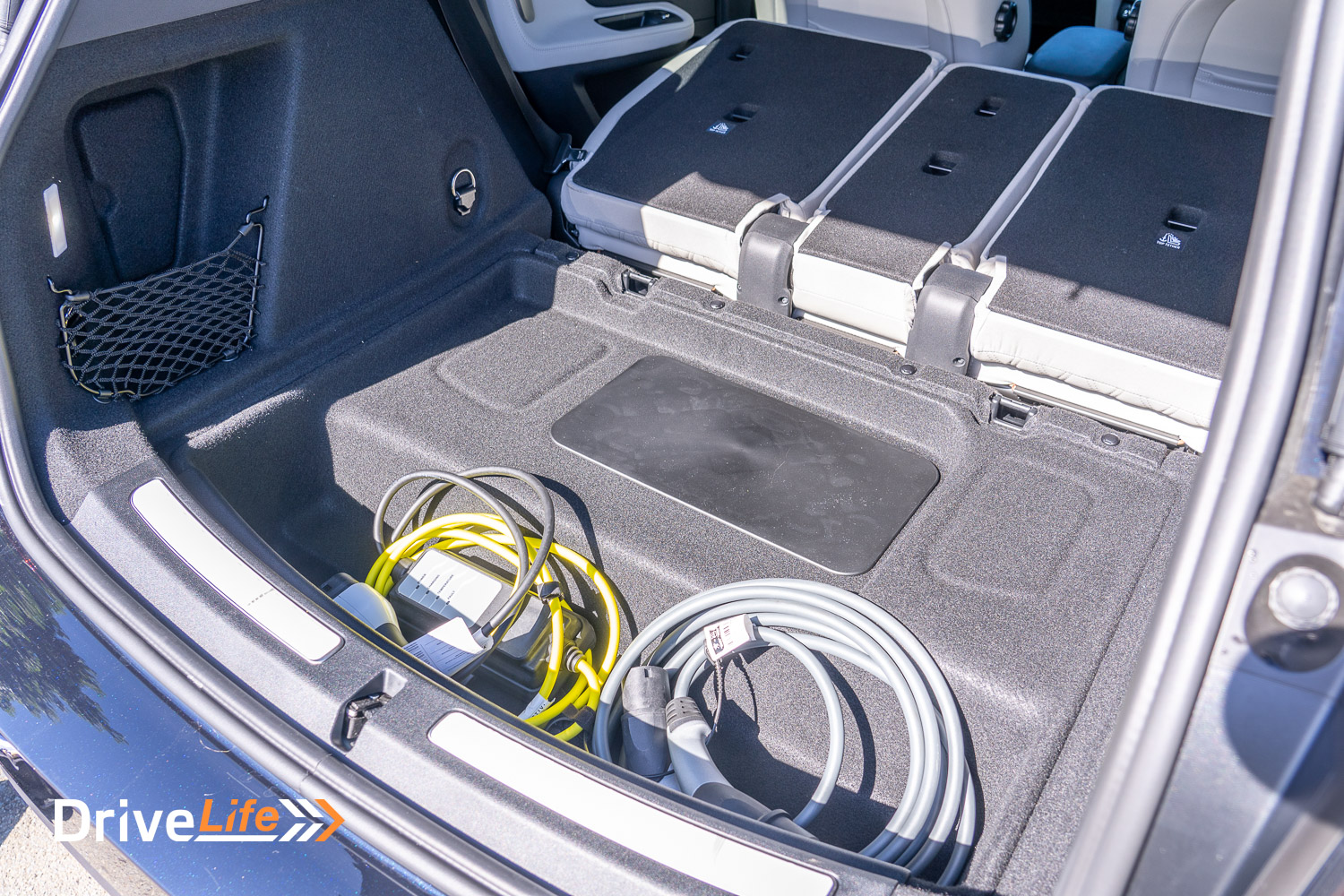


What’s The 2023 MINI Countryman Hybrid Yours Like To Drive?
The hybrid version of the Countryman uses its petrol motor to drive the front wheels and an electric motor to drive the rear wheels, making it all-wheel drive. We experienced the hybrid’s 1.5-litre, 3-cylinder turbo motor when we drove the BMW X1 from Auckland to Wellington. In the Countryman, the engine is still superb – when accelerating hard, it makes some amazing noises that only a three-cylinder engine can make. Then, on the motorway, it’s almost silent and a model of civility. This is a great engine, have no doubt.
You’ll see there’s a variety of automatic gearboxes for the Countryman range, and in the hybrid that means 6-speed automatic transmission. It works just fine, with smooth changes up and down the ‘box, as you’d expect.
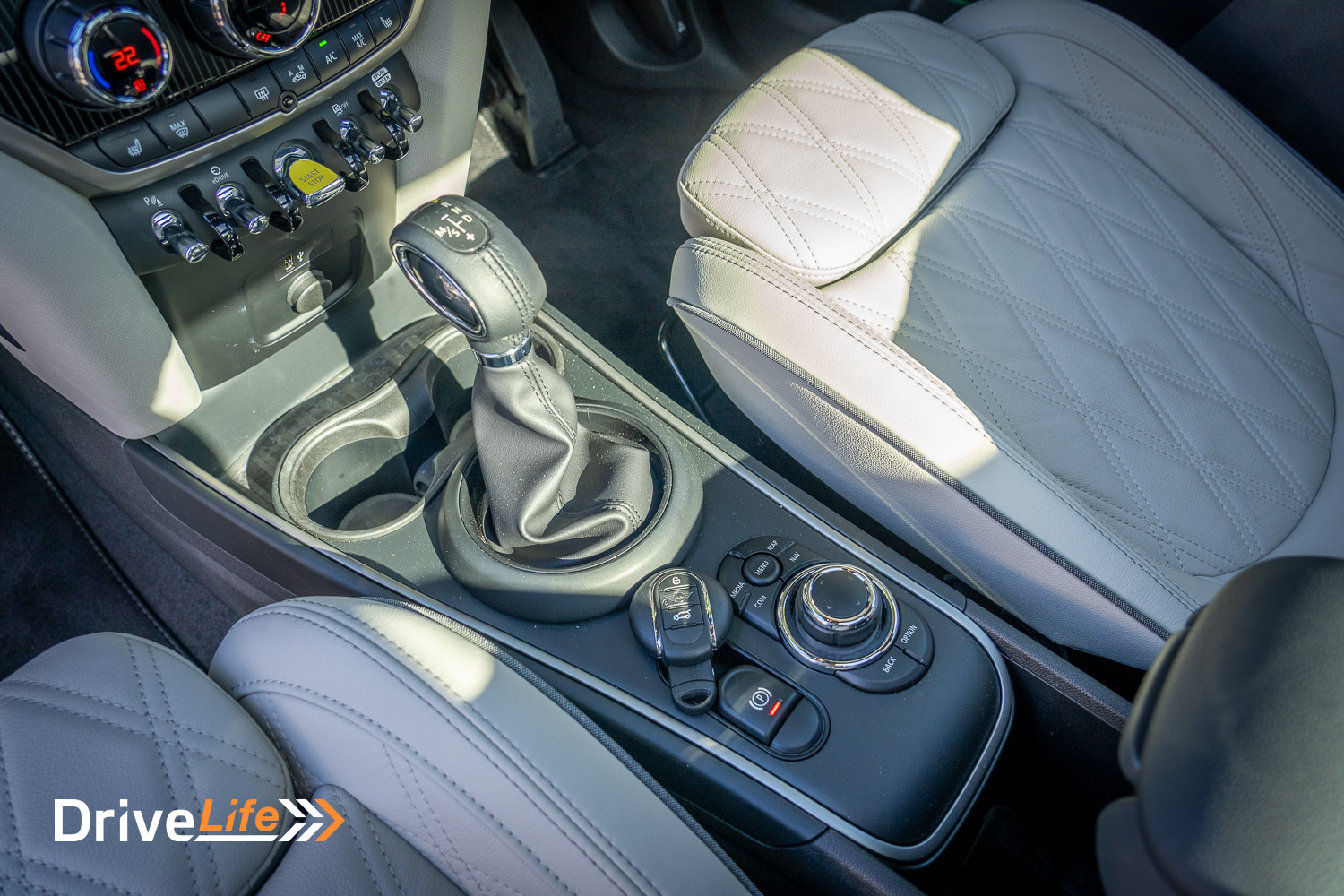
So, what about the hybrid side of the Countryman? It’s all pretty simple and easy. One thing to note is that there is no “EV” button to force the Countryman Hybrid to only drive using the battery. Instead, you get some driving options that affect how often the car will start the petrol motor. The key to this is the yellow bars on the power meter, on the left side of the dashboard. Effectively, changing the hybrid options moves the yellow bar up or down; when you go beyond the yellow bar, the engine will start. The caveat to this is Sport mode – as you’d expect, as soon as you select Sport mode, the petrol engine will start – except if you are using e-Drive Max.



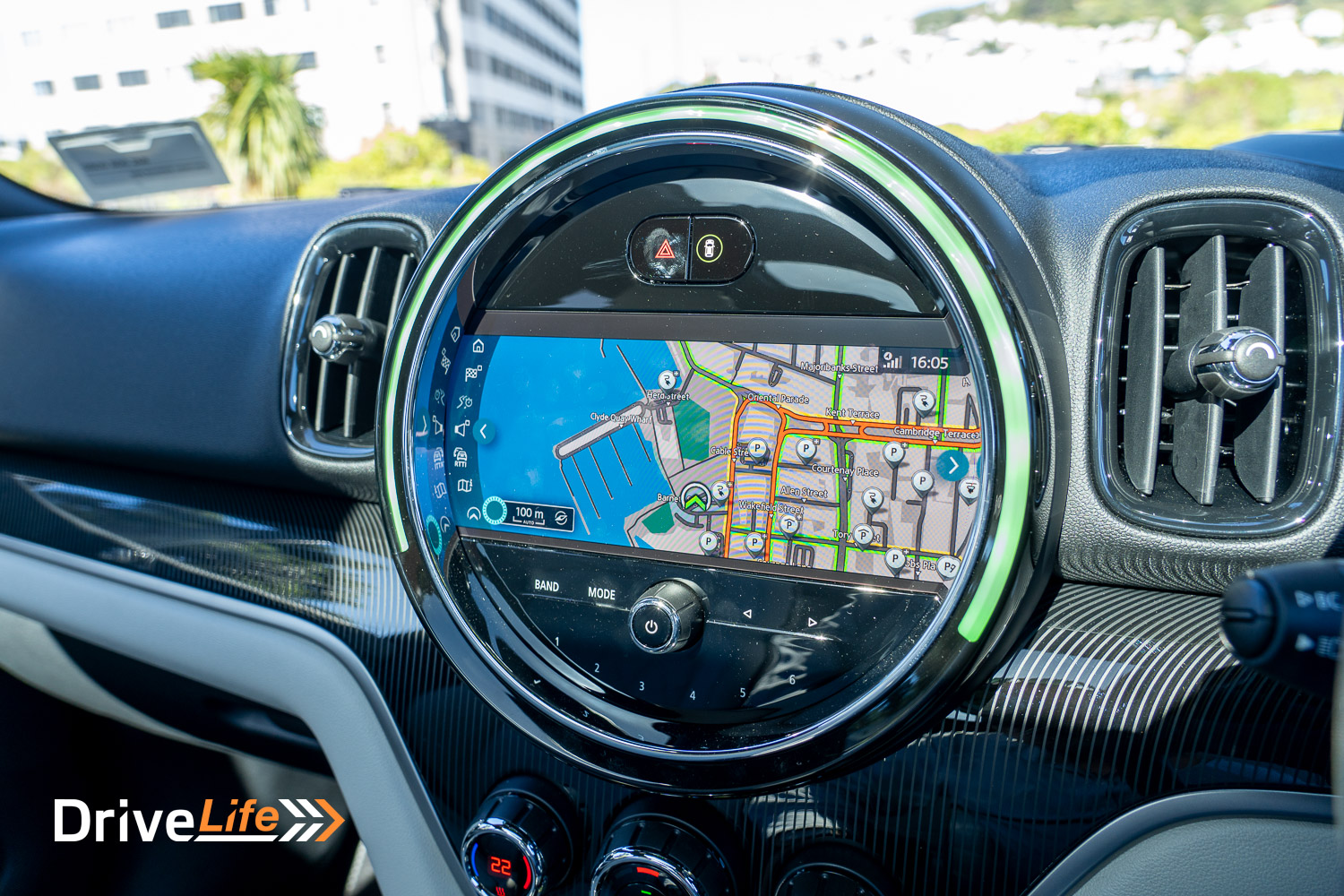

This means two controls over PHEV driving. On the bank of toggle switches on the lower console, there is a Drive Mode button where you can choose from Green, Mid, or Sport. The car always defaults to Mid, and I spent 90% of my week with the car in that mode. It’s a good balance of EV driving and available performance. In saying that, switching the car to ‘Green’ still gives ample performance, easily enough for everyday driving. And if you get into a jam, slamming the accelerator down will start the petrol engine, giving you a big boost of power.

As mentioned, switching the car to Sport mode generally will start the engine straight away. In Sport mode, the car is very responsive and acceleration is brisk. The fastest the Countryman Hybrid will get to 100km/h is 6.8 seconds, a respectable time. I’ve already mentioned the engine noise, but it’s worth more. It sounds so good when you wind it out to the redline, I am certain that doing this doesn’t help your hybrid fuel economy – but that’s the addictive nature of this engine.
You can also force the petrol engine to start by slipping the gear lever into Manual mode, by moving it to the left. There are no paddles in the Countryman Hybrid, so if you want to shift gear manually, you’ll need to flick the lever up or down – once it’s in Manual mode.

No paddles also means you can’t control the brake regeneration (regen) via paddles. There’s no adjustment or ability to turn on regen; going down a hill or braking will kick it in, but if braking you are losing some of that potential to the brakes. I’m hoping the new model of Countryman Hybrid does have some sort of brake regeneration.
So, there is a drive mode toggle but there is also another toggle to change the car’s hybrid settings a little. The options are E-Drive Max, E-Drive Auto, and Save. You can set the car to default to E-Drive Max in the menus.
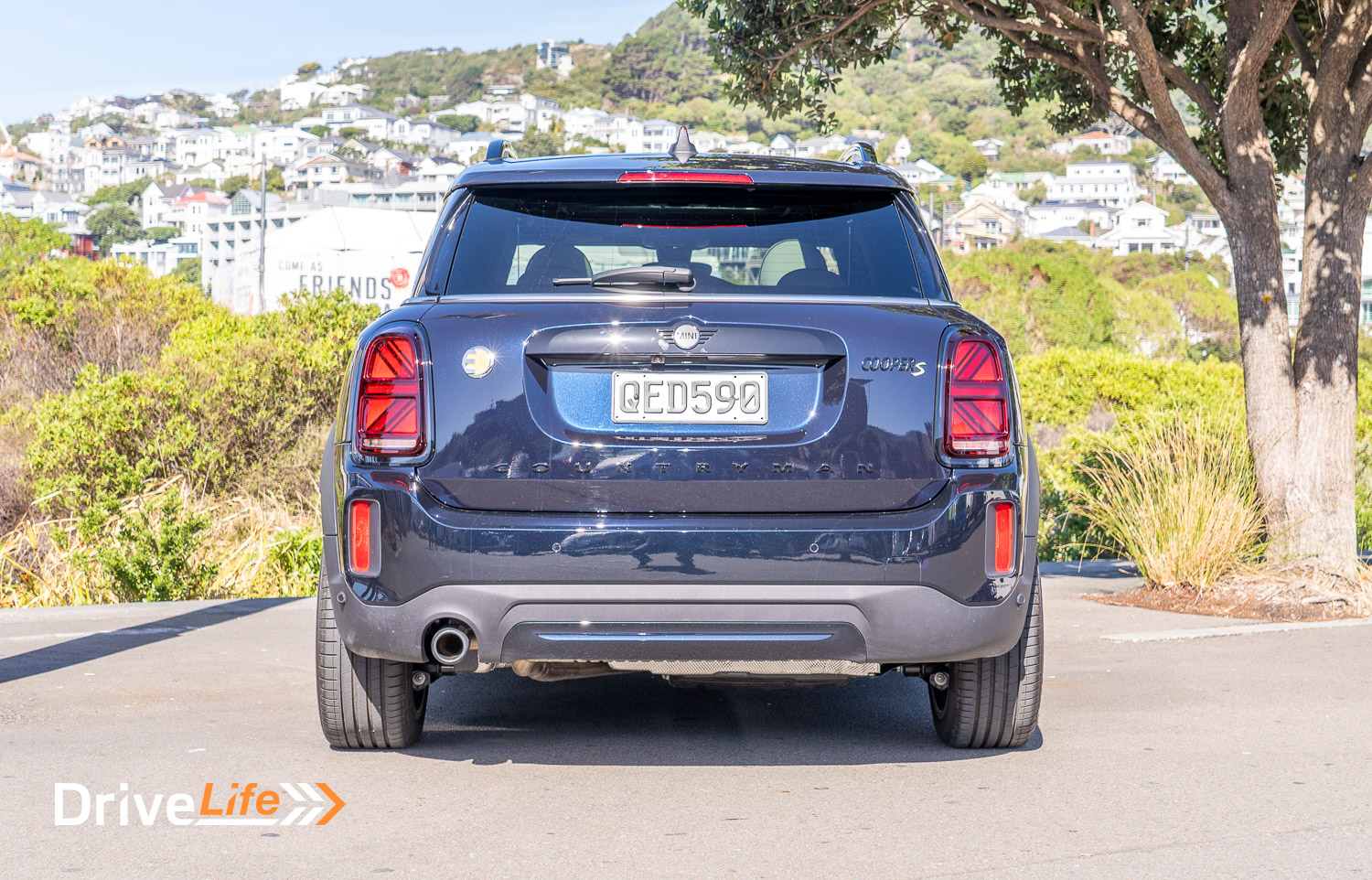
As it sounds, E-Drive Max means the car will do its best to stay in EV mode and for the driver that means keeping the car in the yellow area on the power meter. It’s much easier than it sounds, and certainly trains you to drive a little more softly to stay ‘yellow’. E-Drive Max will see a drop in performance but that’s fine, you will cope. E-Drive Auto is the normal default mode for the hybrid system and like ‘Mid’ for the drive modes, it’s an easy solution to just leave the car in E-Drive Auto. Again, it’s a nice balance of energy economy and performance. Save, like other hybrids that have this option, will start the petrol engine up to charge the drive battery. This is mainly used in other countries where there are areas where you legally must not drive a petrol or diesel car.
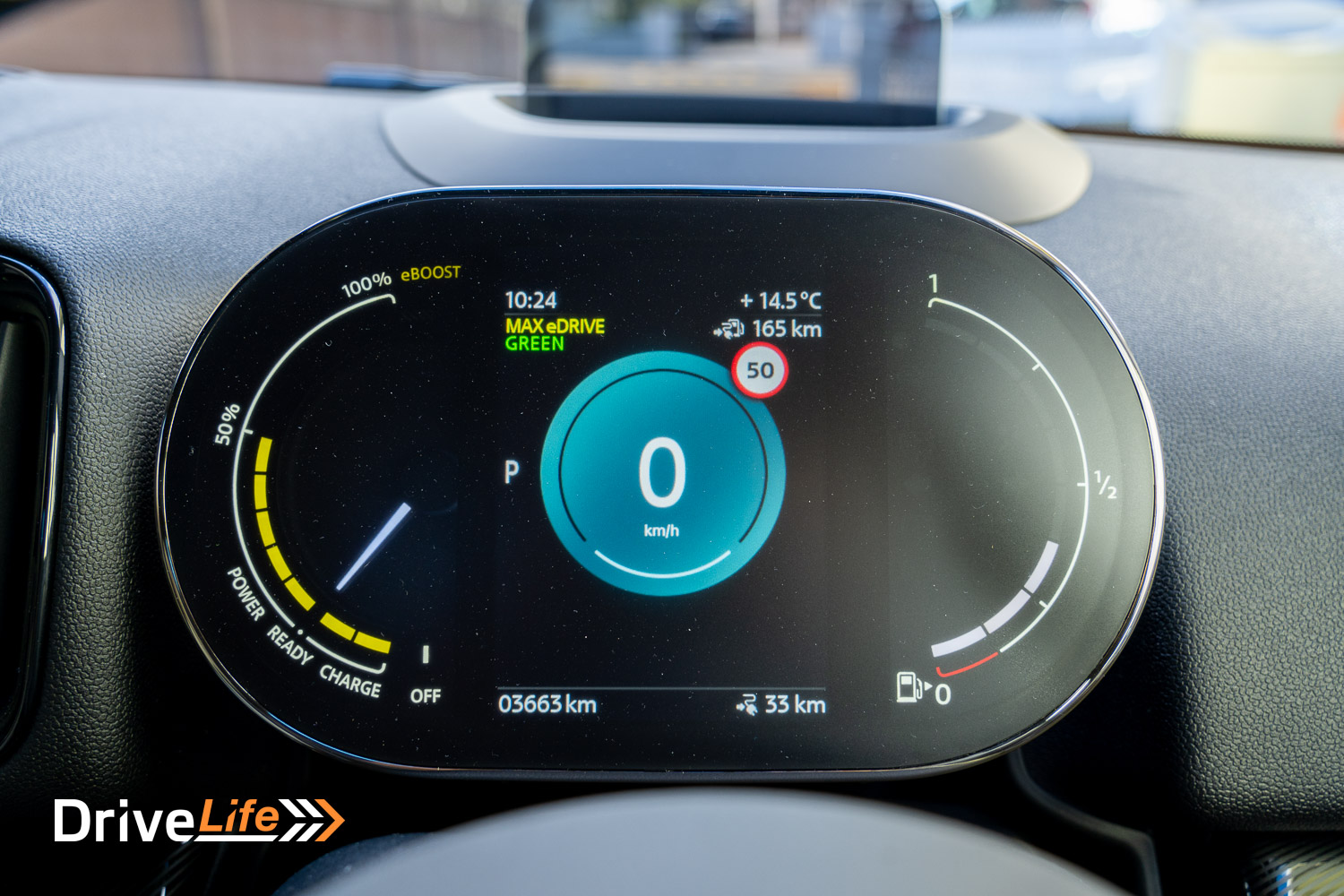
As mentioned, the Daily Drive is pretty easy in the Countryman Hybrid, but what about other aspects of the car? It’s mostly good news here, with a star of the showing being the visibility; it’s outstanding and while I mentioned that those big side windows and upright C pillars contribute to a nice airy interior, they also make for driving visibility that is top of the class. That’s a huge benefit for driving safety and also since there is no blind spot monitoring (even at $75K), you need to be able to see out of the car well on the motorway.

A nice, chunky leather steering wheel gives the driver better control and feels great too. Unfortunately, the Countryman has semi-haptic steering wheel controls and at times (for example) the audio volume would increase as I didn’t realise I was resting my palm on the volume up control. They aren’t as bad as say a Mercedes-Benz, but still no competition for good ‘ole physical steering wheel buttons and thumbwheels. I hope these are gone on the latest model.

I guess if we’re talking about things that are disliked, there’s one more villain here – the indicators. Like some BMW models, they don’t click and lock on, so at times – say indicating right then left at a roundabout – you end up flicking the indicator stalk left-right-left-right to try to eventually turn them off. It’s all a bit painful, so please MINI just give us a normal indicator system. The one in the Countryman isn’t bad, but can be annoying.
Not helping on the daily drive is the lack of adaptive cruise control; at $75K, this is a must, but the Countryman Hybrid loses this feature. To finish my complaints on using the Countryman Hybrid as a commuter is the driver’s sun visor – it’s far too short. I’ve been mentioning this for years, as the visor barely covers half of the driver’s window so you can end up with sun blasting in on the side of your face. It’s quite wearing and for me, feels a little dangerous. A sliding sun visor would fix this in an instant. Maybe they sell them aftermarket on Aliexpress.

Let’s get back to more positive aspects of the car. The dashboard is crisp and clear, even without a cowl. No matter how bright it is outside or what the sun is shining on the dashboard, you can always read the instruments. There is also the heads-up display (HUD). It’s not a true HUD that reflects onto the windscreen and instead is like the Mazda version where your speed, the current speed limit, and any SatNav directions are displayed on a piece of plastic to flicks up above the dashboard. It’s usable and still safer than looking down at the dashboard speedo every 30 seconds to make sure you aren’t speeding.



Of course, there is also the centre touchscreen. I’m not sure why MINI hasn’t just made the entire circle area a screen but instead, it’s a rectangular screen inside a big circle. This does mean you get an actual volume/power on/power off knob for audio below the screen, so that’s a plus in my books. The reversing camera screen has good resolution but due to the size of the screen, it’s not a massive view. There’s also no 360-degree camera system in this car.
But you do get SatNav as standard, and clear directions are shown in the HUD. Like the reversing camera, the map display on the centre screen is pretty small. I found the voice command system in the Countryman really struggled to take commands from me when I was using it to navigate, so defaulted to manually typing in an address.

There is a huge LED light going around the top half of the centre screen, and you can select what you want that light to represent; options include road speed, audio linking, battery state of charge, or you can link it to the car’s ambient lighting instead. That centre screen has some options to change things on the car such as door locking and lighting, but weirdly there is no EV or PHEV display to show you what the car is doing – what motor it is using to drive you. I mention this because that engine can be so very quiet, at times it’s almost impossible to tell if the car is in EV mode or using the petrol engine, or both. If you push that gas pedal hard the engine will start and you can hear it if you are really moving, but in everyday driving, it can be hard to determine. Not that it really matters, but it’d be nice to know. In relation to this is the transition between (for example) petrol and EV modes. It’s so seamless and smooth, you cannot use this as an indicator that you’ve switched from one more to the other. MINI/BMW have really nailed this aspect of hybrid driving.
While the engine noise is enjoyable, the Harmon Kardon sound system is not. It struggles with higher frequencies, the mid-range is pretty flat.

Another noise issue is road, tyre and wind noise – they are all higher than they should be. Even on smooth roads, there is still tyre noise, and coarse-chip seal will make those 225/45/19 Pirelli P-Zero tyres sing pretty loudly. This is an area that needs improvement. The upside of those P-Zeroes is grip; with all-wheel drive and sticky Pirellis, grip is first class. Overall handling is ok – keep in mind this is a car with a long wheelbase and a fairly chunky weight of 1,807kg. It does well until physics kicks in. But as already mentioned, it’s still a fun car. Those low-profile tyres do contribute to a ride that’s a little choppy at times when travelling over sharp bumps, but on the whole, it is fairly compliant.

If you need to stop in a hurry, the brakes are excellent and a highlight of this car. There is superb brake feel and the available braking power is outstanding.
After our 700km of testing in mixed conditions, our MINI test car returned 4.1L/100km – a good result. Not as good as the 0.9L/100km I got out of the Opel Astra PHEV, but I did really try to do my best to save fuel in that model. In saying that, the Astra does have an EV mode button whereas I found it a little too easy to have the MINI start its petrol engine up. My average EV range when charging the car to 100% was around 50km, and occasionally I’d see 55km.

2023 MINI Countryman Hybrid Yours – Specifications
| Vehicle Type | 5-door all-wheel drive compact-crossover SUV |
| Starting Price | $75,850 |
| Price as Tested | $75,850 |
| Engine | 1.5-litre, 3-cylinder petrol with plug-in hybrid (PHEV) capability |
| Power, Torque kW/Nm | 165/385 (combined) |
| Transmission | 6-speed automatic |
| Spare Wheel | – |
| Kerb Weight, Kg | 1,807 |
| Length x Width x Height mm | 4297x1559x1822 |
| Boot Space / Cargo Capacity, Litres (seats up/seats down) | 405/NA |
| Fuel tank capacity, litres | 36 |
| Fuel Economy, L/100km | Advertised Spec – Combined – 2.4 Real-World Test – Combined – 4.1 Low Usage: 0-6 / Medium Usage 6-12 / High Usage 12+ |
| Towing Capacity Kg, unbraked/braked | 750/1,500 |
| Turning circle metres | 11.4 Small: 6-10m / Medium 10-12m / Large 12m+ |
| Warranty | 5 years, 100,000km |
| Safety information | ANCAP Rating – Unrated – Link Rightcar.govt.nz – 5 Stars – QED590 |
Have you enjoyed this review? Be sure to join our monthly email newsletter list so you don’t miss a single car review!








